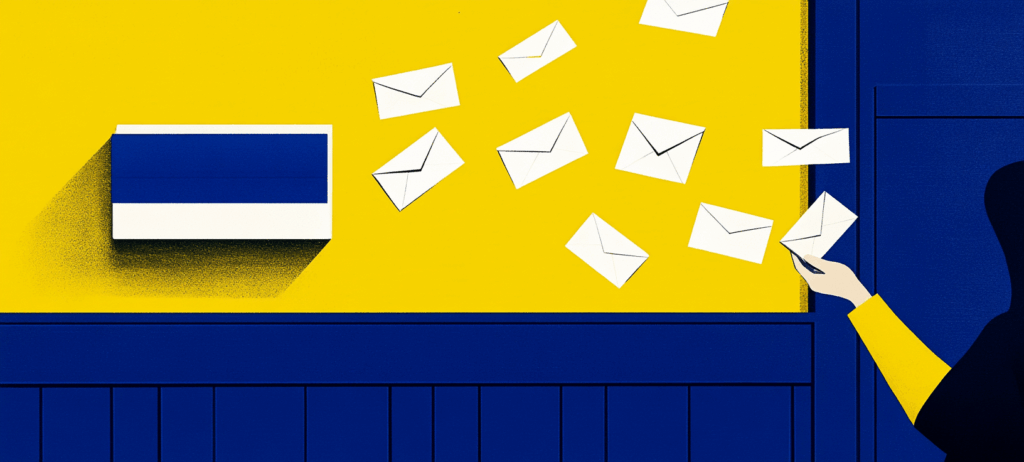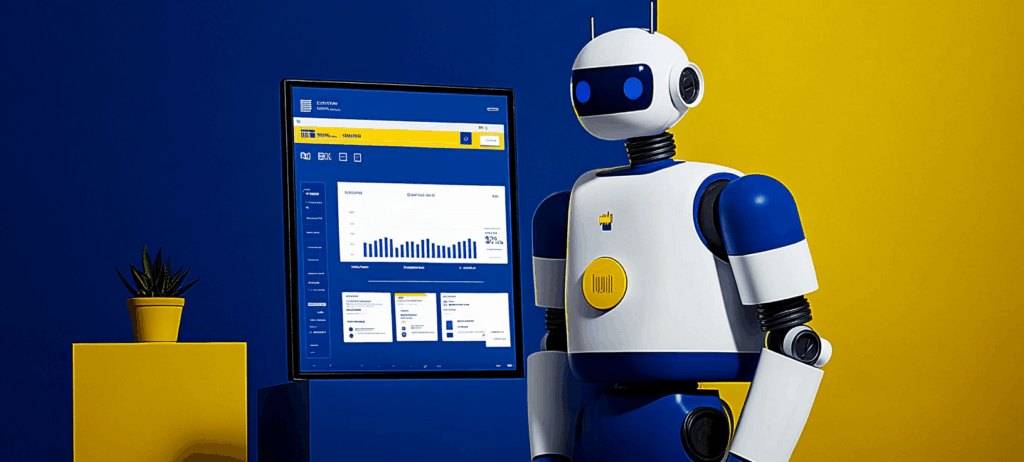-
 Published: Aug 18, 2025
Published: Aug 18, 2025
-
 8 min. read
8 min. read
-
Summarize in ChatGPT
-
 Thaakirah Abrahams
Thaakirah Abrahams WebFX Editor
WebFX Editor
- Thaakirah Abrahams is a Marketing Editor at WebFX, where she leverages her years of experience to craft compelling website content. With a background in Journalism and Media studies and certifications in inbound marketing, she holds a keen eye for detail and a talent for breaking down complex topics for numerous sectors, including the legal and finance industries. When she’s not writing or optimizing content, Thaakirah enjoys the simple pleasures of reading in her garden and spending quality time with her family during game nights.
Table of Contents
- Real-world AI marketing examples from top brands
- 1. Coca-Cola’s AI-powered creativity
- 2. Sephora’s AI chatbot-powered shopping service
- 3. Calm App’s use of Amazon Personalize
- 4. Netflix’s user content suggestion tool
- 5. Starbucks’ AI-powered chatbot
- 6. Lidl’s AI-generated product campaign
- 7. BuzzFeed’s AI quizzes
- 8. Nike’s AI-generated ad featuring Serena Williams
- 9. Farfetch’s AI-optimized emails
- 10. British Council’s localized AI-powered ads
- Start implementing powerful AI marketing techniques to gain a competitive advantage
The top 10 AI marketing examples
- Coca-Cola’s new AI-powered platform, Fizzion, helps designers develop on-brand design elements at scale for increased efficiency and reduced errors.
- Sephora’s AI chatbot-powered shopping service allows users to apply makeup products virtually before purchase.
- Calm App’s use of Amazon Personalize to recommend to users the most popular and relevant content.
- Netflix’s user content suggestion tool provides personalized recommendations based on user watch history and preferences.
- Starbucks’ new generative AI chatbot assistant communicates with baristas in real-time to assist them with drink recipes and equipment troubleshooting.
- Lidl’s AI-powered platform encouraged customers to generate AI-created product designs with Lidl’s signature colors.
- BuzzFeed’s AI-powered quizzes are more personalized with responses that are unique to individual users.
- Nike’s Serena Williams ad uses AI and historical data to inspire its athletic audience to improve their techniques.
- Farfetch’s partnership with Jacquard to boost its email performance and fine-tune brand messaging.
- British Council’s use of AI to generate over 1,000 localized ad variations in seven languages.
AI is advancing numerous aspects of marketing, including marketing automation, content creation, digital advertising, and social media marketing. AI-powered tools offer real-time insights into consumer behavior and the functionality to automate personalized suggestions.
Many well-known companies are already leading the way in AI marketing best practices. In this guide, we explore how top brands like Coca-Cola and Netflix are using AI in marketing.
One key commonality between these leading companies and their strategies is that most want to enhance personalization through AI marketing. These top 10 real-life AI marketing examples will also help you envision how your brand can implement them.
If you want to stay updated on the latest AI trends, join Revenue Weekly for exclusive tips!
🎥Video: 5 incredible benefits of AI in marketing
Real-world AI marketing examples from top brands
Here’s how global companies are turning AI-powered personalization into serious ROI.
- AI personalization examples
- AI marketing automation examples
- AI content creation and optimization examples
AI personalization examples
Many companies are using AI to improve personalization, with Coca-Cola and Sephora taking the lead in effective approaches to personalization and engagement.
1. Coca-Cola’s AI-powered creativity

Coca-Cola recently collaborated with Adobe to help creative teams develop content faster while maintaining originality, quality, and integrity.
This Fizzion campaign includes a design-first system that learns from and empowers designers. Fizzion adopted Coca-Cola brand guidelines to ensure that design elements like imagery, type, and logos are on-brand.
📈The result
While this project is still in its pilot phase, Coca-Cola expects that the Fizzion campaign will lead to faster execution, fewer errors, and stronger brand integrity at scale. This will make marketing in over 200 countries much easier for the design team.
🔦How can you implement this technique?
You can produce personalized AI-powered designs at scale, like Coca-Cola, by incorporating platforms like Adobe and Jasper.
Adobe Firefly is a generative AI design model, and Adobe Express is an all-in-one AI content creation tool that helps you create on-brand visuals for marketing materials.
Jasper is another great AI platform for building marketing content that you can explore. In addition to its feature that generates on-brand AI-powered images, the platform also learns your company’s unique brand voice and style to continually create on-brand marketing copy.
Here’s how to start:
- Establish your brand: On your chosen platform, you can train the AI on your company’s visual identity by defining your brand colors, uploading your logos, and selecting your fonts.
- Generate on-brand designs: Use text prompts to ask the AI model to create designs and images for your campaign.
- Review and refine content: Your marketing and design team can then tweak the content to ensure that it perfectly aligns with your brand’s quality standards.
2. Sephora’s AI chatbot-powered shopping service
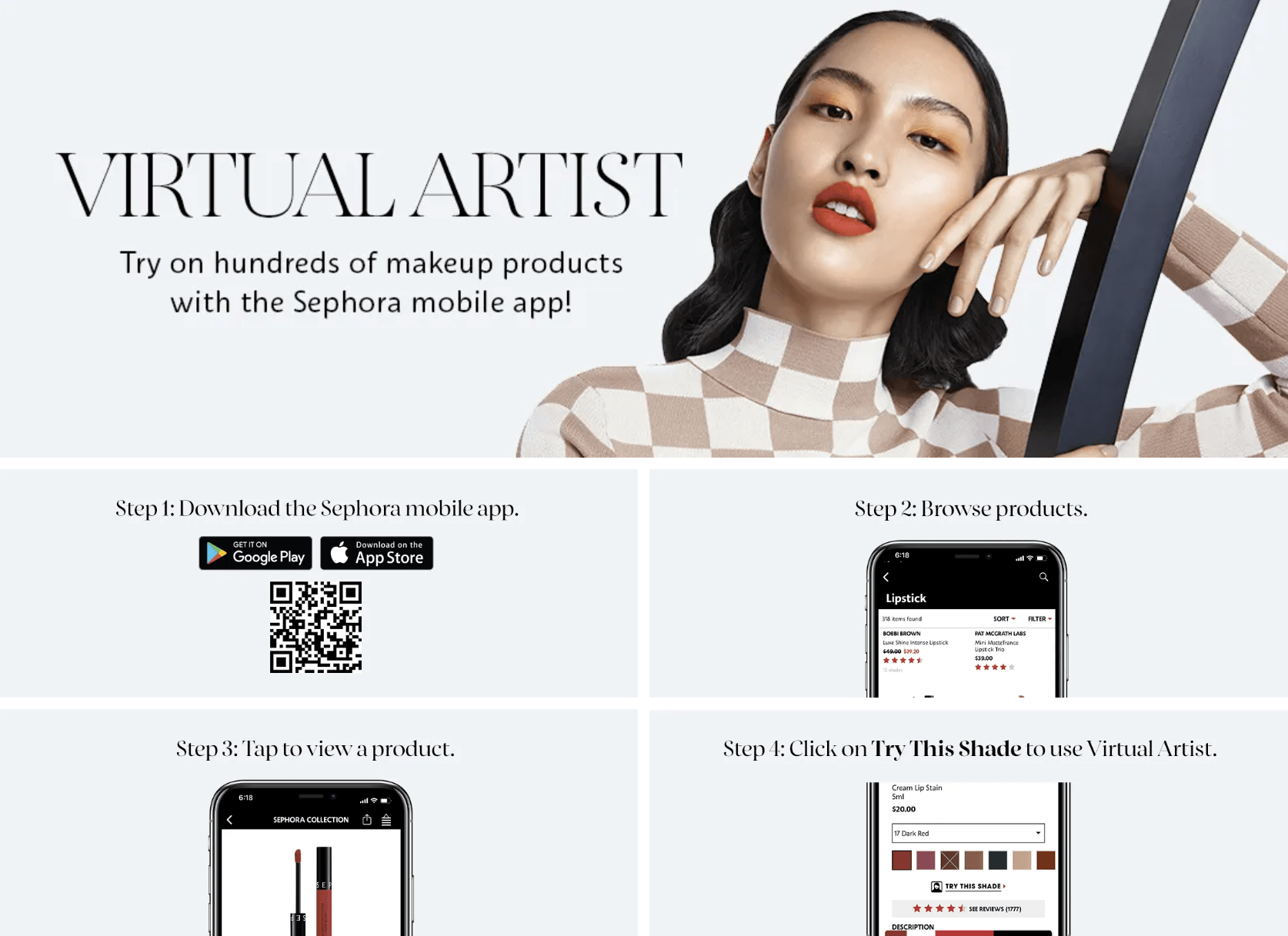
The cosmetics brand Sephora stunned the beauty industry with its new AI-powered virtual artist app, which allows consumers to try on makeup virtually.
The idea stemmed from consumer research, when the brand discovered that consumers often feel overwhelmed by the wide range of products available.
To combat this challenge, Sephora launched a chatbot-powered interactive quiz that guides users through the shopping process.
The chatbot offers tailored tips based on a user’s answers. It also uses facial recognition technology to scan a user’s face and experiment with different makeup products in real time.
This feature enables users to receive personalized product recommendations based on their preferences and skin tone.
This initiative was a major success and allowed Sephora to host its own chatbot-powered shopping service through Facebook Messenger. Users also benefited from the campaign because they could accurately choose products that would suit them, boosting customer confidence. Do you have a large selection of products or services? Empower customers to make more informed purchase decisions with a chatbot-led shopping service. This type of service can help you increase personalization and customer confidence, driving increased sales for your company. Looking into WebFX’s Facebook Messenger chatbot marketing services is a great place to start. Facebook Messenger chatbots communicate directly with your audience and help them take the appropriate next steps, creating a personalized experience. WebFX takes it a step further by ensuring that the chatbot is specific to your industry, company, and goals, boosting your leads and ROI. Here’s how to start: 📈The result
🔦How can you implement this technique?
3. Calm App’s use of Amazon Personalize
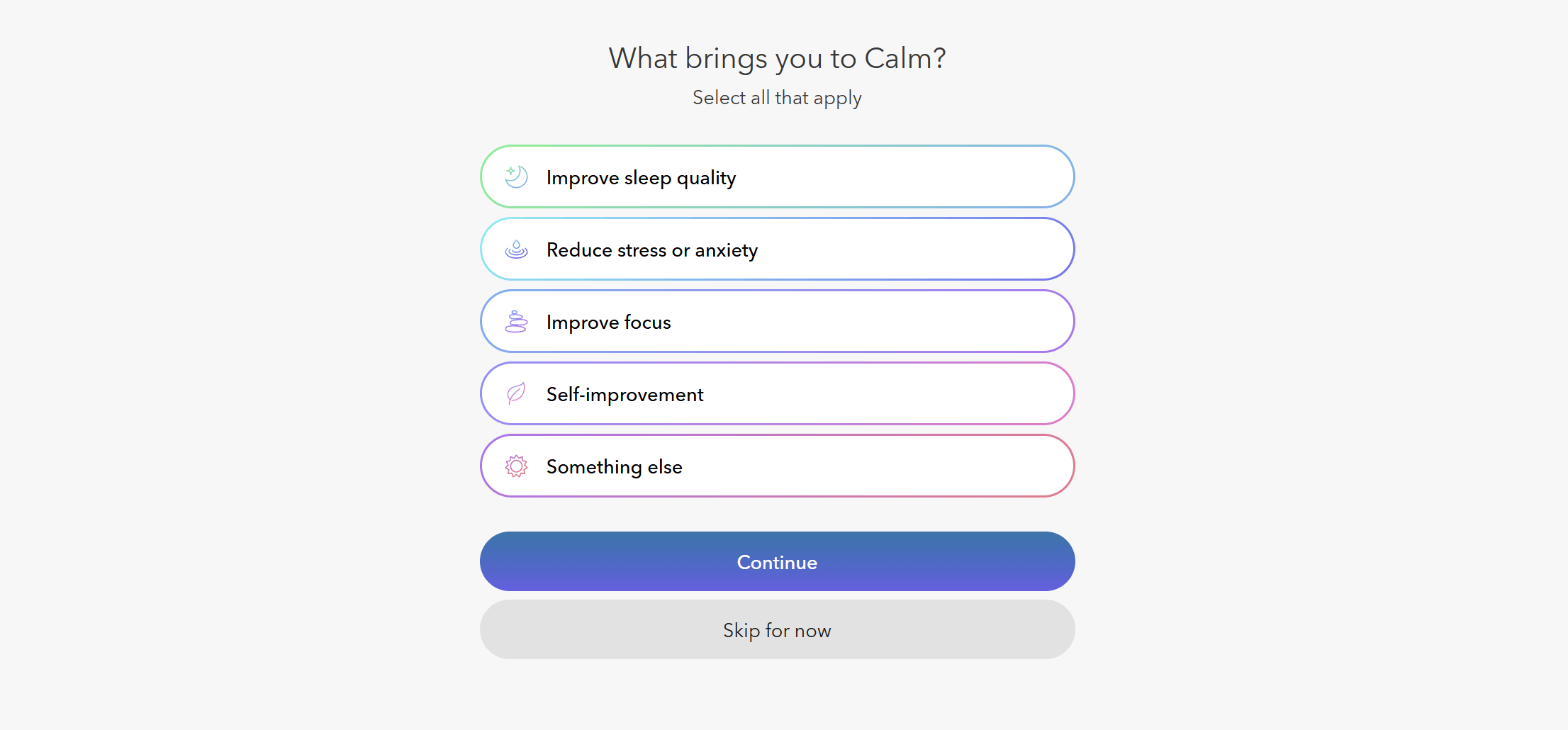
The popular mobile application, Calm, promotes mental well-being through numerous relaxation and mindfulness techniques. Calm needed a solution that would help users find the right content for them among a large and expanding content library within the app.
That’s where Amazon Personalize came in. Amazon Personalize is a product of Amazon Web Services (AWS) that provides shoppers with personalized product recommendations through AI.
Calm used Amazon Personalize to recommend to users the most popular content that they showed a preference for, while removing recommendations they had already listened to. This method allowed recommendations to stay fresh and continuously align with user preferences.
📈The result
Calm increased its daily app use by 3.4% after training Amazon Personalize with Calm’s data. This was a huge success for the company, considering that the metric included various factors across customer personas, engagement, and retention.
🔦How can you implement this technique?
Calm shows us that another great way to enhance personalization is through incorporating a recommendation engine like Amazon Personalize or Google Cloud Recommendations AI into your website or app.
Both platforms analyze each user’s individual needs, behavior, and preferences to ensure your website’s visitors get more specific product recommendations, driving engagement and higher conversion rates.
Here’s how to start:
- Integrate your data: Feed the AI-powered tool your customer, product, and content catalog data.
- Choose a recommendation recipe: Select the rules for recommending products based on individual users. This could also include adding features like “Customers Also Bought” and “Frequently Viewed Together” to ensure users get the right recommendations.
- Launch and test: Place your recommendation widgets on key pages and monitor how they impact user engagement and conversions.
AI marketing automation examples
Some companies, like Netflix and Starbucks, are using AI-powered marketing automation to personalize their services and cater to user demands.
4. Netflix’s user content suggestion tool
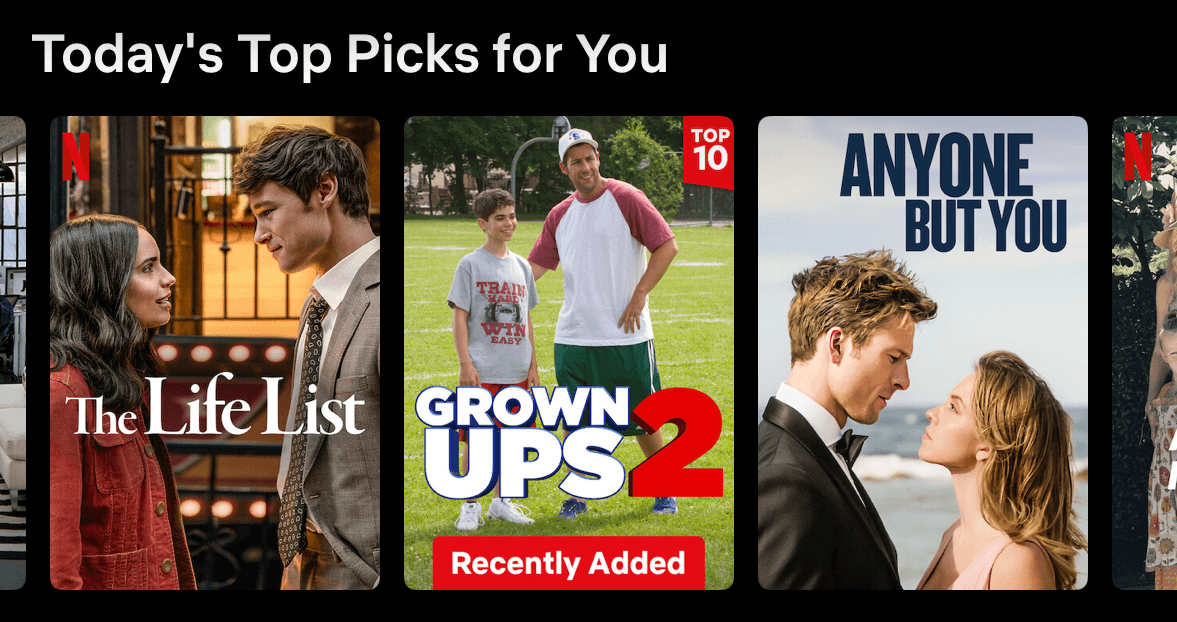
Netflix, the leading content streaming service, enhanced its user experience (UX) and personalization with a new AI marketing strategy.
Using AI-driven machine learning technology, Netflix personalizes content recommendations based on user watch history, location, ratings, and preferences. They also use AI development to automatically optimize streaming quality and prevent buffering and quality issues.
📈The result
People chose and watched over 80% of the shows Netflix recommended through its personal recommendations initiative.
🔦How can you implement this technique?
To use this AI marketing example as inspiration for your next AI-powered initiative, be more proactive in personalizing recommendations based on your target audience.
One of the best ways to use AI in marketing is to ensure the website optimizes user experience and personalization. Doing so will allow your consumers to get the most out of your brand.
Two AI-powered platforms to explore that help you provide Netflix-level suggestions include:
- Dynamic Yield: Dynamic Yield personalizes all customer touchpoints and adapts your website’s content, layout, and promotions for each user based on their behavior.
- Bloomreach: Bloomreach is beneficial for content-heavy and e-commerce websites. The platform re-ranks search results and category pages to show the user the most relevant items first, improving the user experience.
Here’s how you can start implementing these tools:
- Define your goal: Define where you need to improve personalization, whether it’s recommending relevant content or improving on-site search features.
- Integrate data: Integrate your audience, historical, and product data with your chosen AI-powered platform.
- Incorporate A/B testing: Before launch, consider implementing A/B testing to see which features get more clicks.
5. Starbucks’ AI-powered chatbot
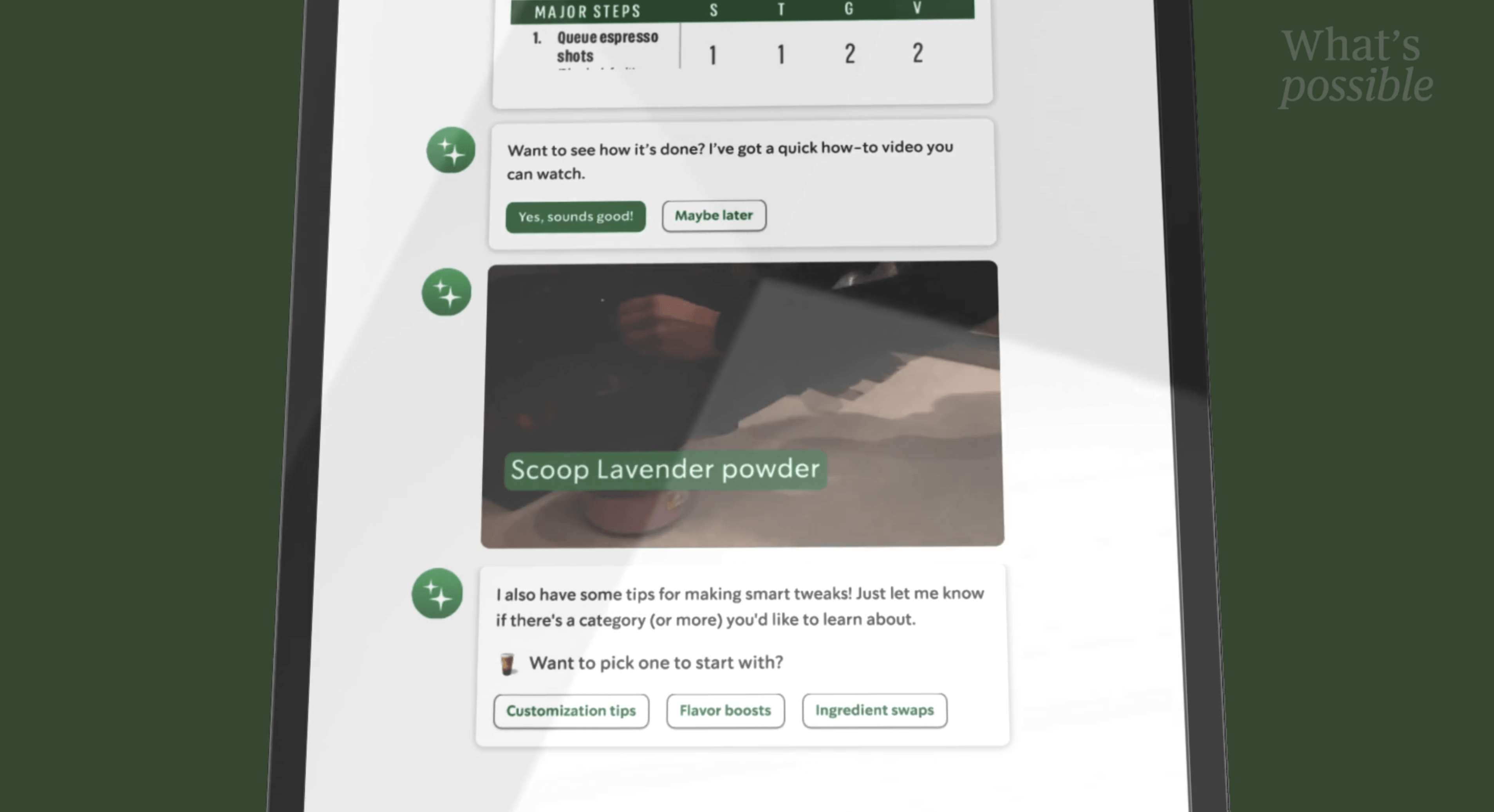
Another recent AI integration is Starbucks’ new generative AI chatbot assistant, called Green Dot Assist. The chatbot interacts with baristas in real time to assist them with drink recipes and equipment troubleshooting.
Starbucks created the system to reduce training time and drink remakes. This innovation should make baristas’ jobs quicker and simpler, improving the hiring and onboarding process.
📈The result
While the campaign is still in its early stages, it is set to pilot in 35 stores in 2026. Starbucks expects that Green Dot Assist will help baristas find quicker solutions to tasks and enhance personalization.
Ultimately, it will improve the customer experience and encourage potential employees to apply for Starbucks barista positions.
🔦How can you implement this technique?
Implement an AI-powered assistant for your customer-facing employees. Start by brainstorming ways this assistant could streamline specific processes that will improve the customer experience and satisfaction.
Create a platform or website that your employees can use to source important information. By leveraging WebFX’s AI and GPT integration services, you can integrate a trained AI-powered chatbot that answers questions in real time.
Here’s how you can start:
- Establish the assistant’s core purpose: Identify which pain points you’d like this strategy to address. Decide how you would like the AI assistant to help, whether it should be a knowledge base expert, a troubleshooting guide, or a tool to speed up onboarding and training.
- Inform the AI assistant: You’ll then gather all the relevant company information to inform the AI assistant. WebFX will use this information to build and train a secure, custom AI model.
- Test and refine the assistant: Test and fine-tune the tool to ensure that it is a user-friendly chatbot interface that your employees can interact with to enhance efficiency and customer service.
6. Lidl’s AI-generated product campaign
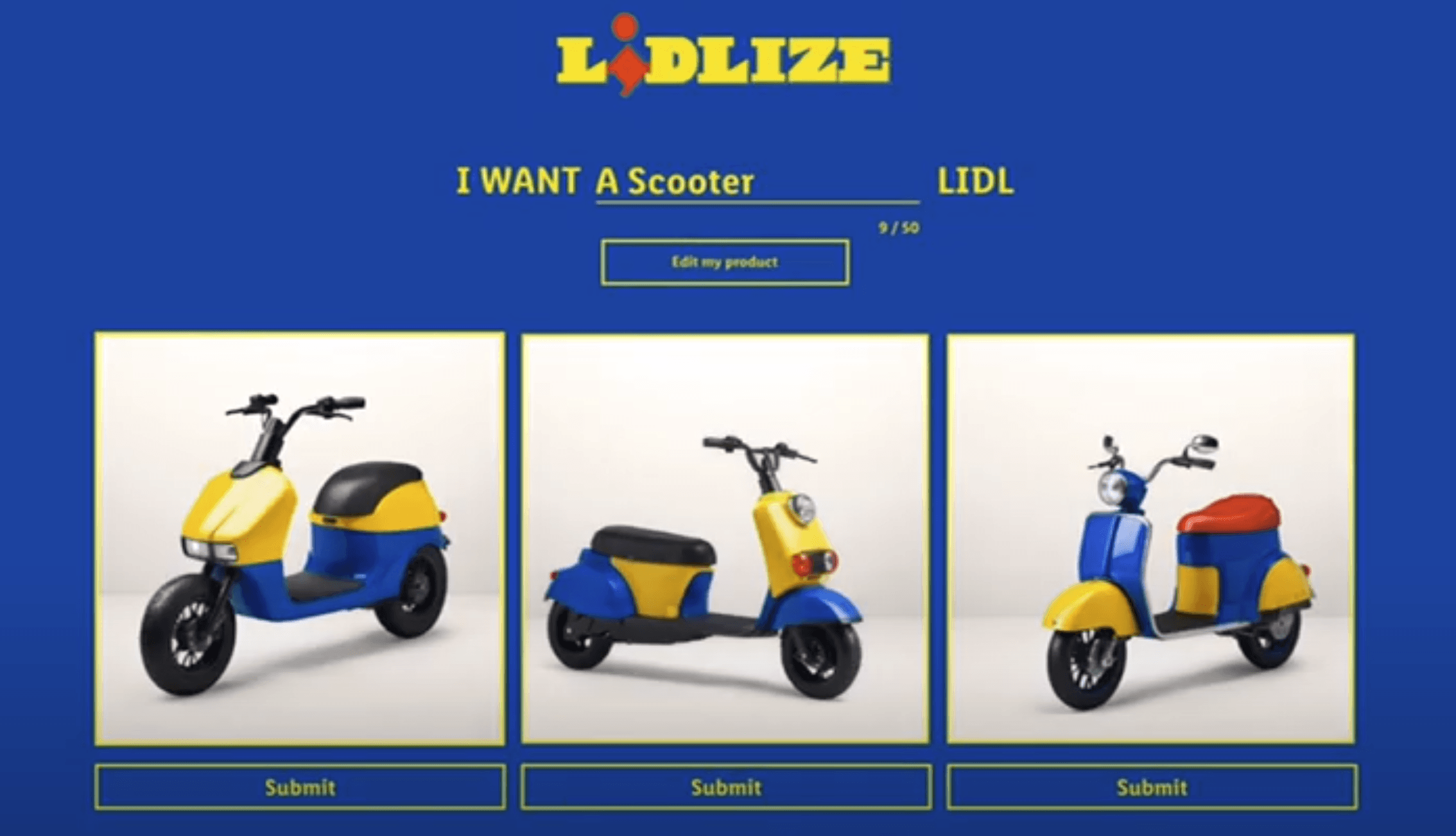
The Lidl grocery store launched a generative AI-powered platform called Lidlize and encouraged customers to get creative with the brand.
Users could use the app to generate AI-created product designs with Lidl’s signature colors. The creation with the most likes became a real Lidl product sold in stores.
📈The result
The campaign went viral, and users created over 1.7 million AI-generated images within three weeks. The direct consumer involvement in product development helped create a deeper connection with the brand.
🔦How can you implement this technique?
If you want to implement something similar, consider offering an AI-powered tool that your audience could use to interact with your brand.
Allow them to participate in the marketing process with AI-generated designs and ideas. This will enable you to form a long-term relationship with your consumers and allow them to feel part of your brand in some way.
Some powerful tools to choose from include OpenAI’s DALL-E 3 API, Adobe Firefly API, and Stable Diffusion API. You’ll use their Application Programming Interface (API) to build a custom tool on your own website.
Here are a few steps you can take to do so:
- Define the creative concept and goal: Establish what the users will create, what’s in it for the user, and the rules to keep the content on-brand.
- Build the campaign: Personalize this tool to your target audience’s interests and ensure that it is simple to use with clearly defined buttons and textboxes.
- Integrate the API: Then, integrate the AI image generation API and promote the campaign across marketing channels. Proper implementation will help you spark consumer engagement, emotional connections, and brand visibility.
Content creation and optimization examples
There are many companies using AI in marketing to generate content ideas, write marketing copy, and create personalized responses to consumers.
Using AI for content creation and optimization streamlines the marketing process. Two key AI marketing examples for this category include BuzzFeed and Grammarly.
7. BuzzFeed’s AI quizzes
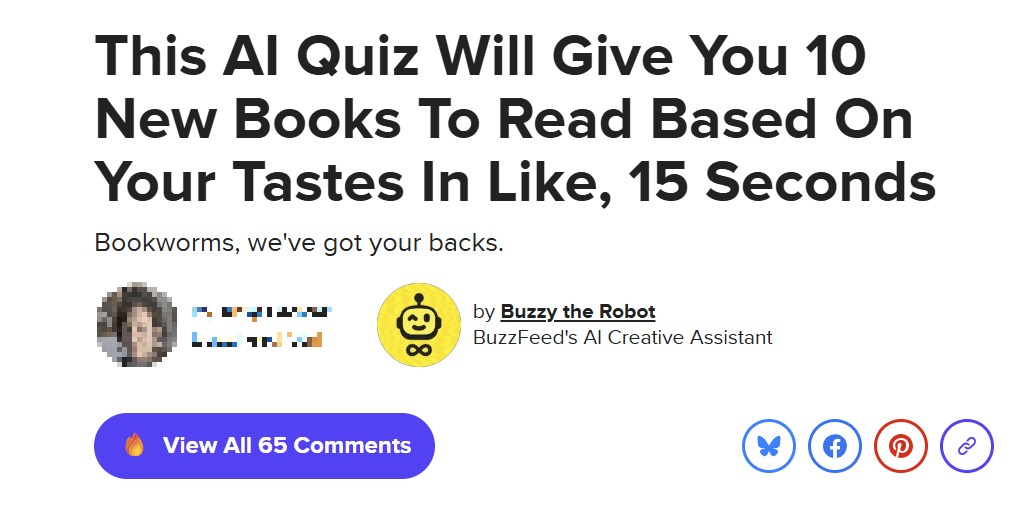
Another great example of AI in marketing is BuzzFeed’s AI-powered quizzes. BuzzFeed is known for its exquisite and insightful quizzes. However, now it’s shying away from cookie-cutter results.
With the use of AI, quizzes are more personalized, with responses unique to each user. As a result, no two users receive the same response, helping the brand connect with users on a deeper level.
📈The result
Results showed that BuzzFeed’s first AI-powered content module boosted page views by 24%. People are also spending 40% more time on BuzzFeed’s AI quizzes than its human-generated ones.
🔦How can you implement this technique?
BuzzFeed’s personalized AI quizzes teach us the importance of creating emotional connections with consumers.
Are you looking to implement quizzes that enhance consumer engagement or help them choose better products and services? Typeform presents exciting opportunities to connect with each user on a personal level and streamline that process.
Typeform integrates AI to help you build engaging quizzes and forms. It pipes your users’ answers into an AI model to generate personalized results.
Here’s how you can start:
- Plan the quiz: Plan your quiz and the possible outcomes you’d like it to have. For example, if you’re a fitness company, you might create a quiz to help potential customers understand which type of personal training workouts they need. Some possible outcomes could include “Strength training,” “Cardio,” “HIIT (High-Intensity Interval Training),” or “Yoga.”
- Build an engaging quiz: Build your quiz in Typeform while making it feel like a conversation. Consider adding images, GIFs, and videos that make the quiz more engaging. For example, we could add GIFs of specific exercises for the fitness quiz to enhance the user’s understanding.
- Create personalization rules: Your next step is to use “Logic Jumps” in Typeform to create personalization rules. For example, when the user chooses the answer “I want to feel healthier,” you can jump them to a question about how exactly they feel unhealthy.
- Set up the quiz outcomes: You’ll then set up the outcomes in Typeform to deliver accurate results based on the user’s answers. For example, answers that suggest a preference for enhanced mobility and flexibility should lead to the “Yoga” result.
8. Nike’s AI-generated ad featuring Serena Williams

On Nike’s 50th anniversary in 2022, the brand commemorated with an award-winning AI-assisted video ad. The video combined AI, data, and sport to honor the career of Serena Williams after she announced her retirement.
The video contained an AI-generated match between the 1999 Serena Williams in her first Gram Slam and the 2017 Australian Open Serena.
AI enabled both versions of the tennis player to model their corresponding styles of play, decision-making, reaction time, recovery time, and more. The aim was to show that Nike uses this data to design more competitive products that align with athletic needs.
📈The result
The match broadcast on YouTube gained 1.7 million views and a 1,082% increase in organic views compared to other Nike content. It inspired tennis fans and athletes to work hard and keep evolving.
🔦How can you implement this technique?
While Nike’s campaign was complex, its success came from creating a powerful, narrative-driven campaign. To incorporate something similar, you’ll need a combination of AI-powered tools for data-driven storytelling.
- Choose which historic data to highlight: Consider highlighting historical data about your company or industry. Create a compelling narrative that allows viewers to connect with your brand. For example, you could showcase the evolution of a product, design style, or cultural trend related to your brand.
- Analyze customer history: Use data analysis platforms like Nutshell to analyze customer history, from purchase to social media interactions. This information will help your marketing team predict the right content and time that will resonate with your audience.
- Track trends and evolutions: Social listening tools like Talkwalker and Brandwatch can help you analyze how trends have evolved over time.
- Write a compelling ad script: Once you have the data, use a large language model (LLM) like TeamAI to help craft a compelling script collaboratively. To do so, you can feed the tool the “then vs. now” data and ask it to write an inspiring, growth-focused script for a short video.
- Create the video ad: Use AI video generation tools like Runway and HeyGen to create your ad and save money on ad production.
9. Farfetch’s AI-optimized emails
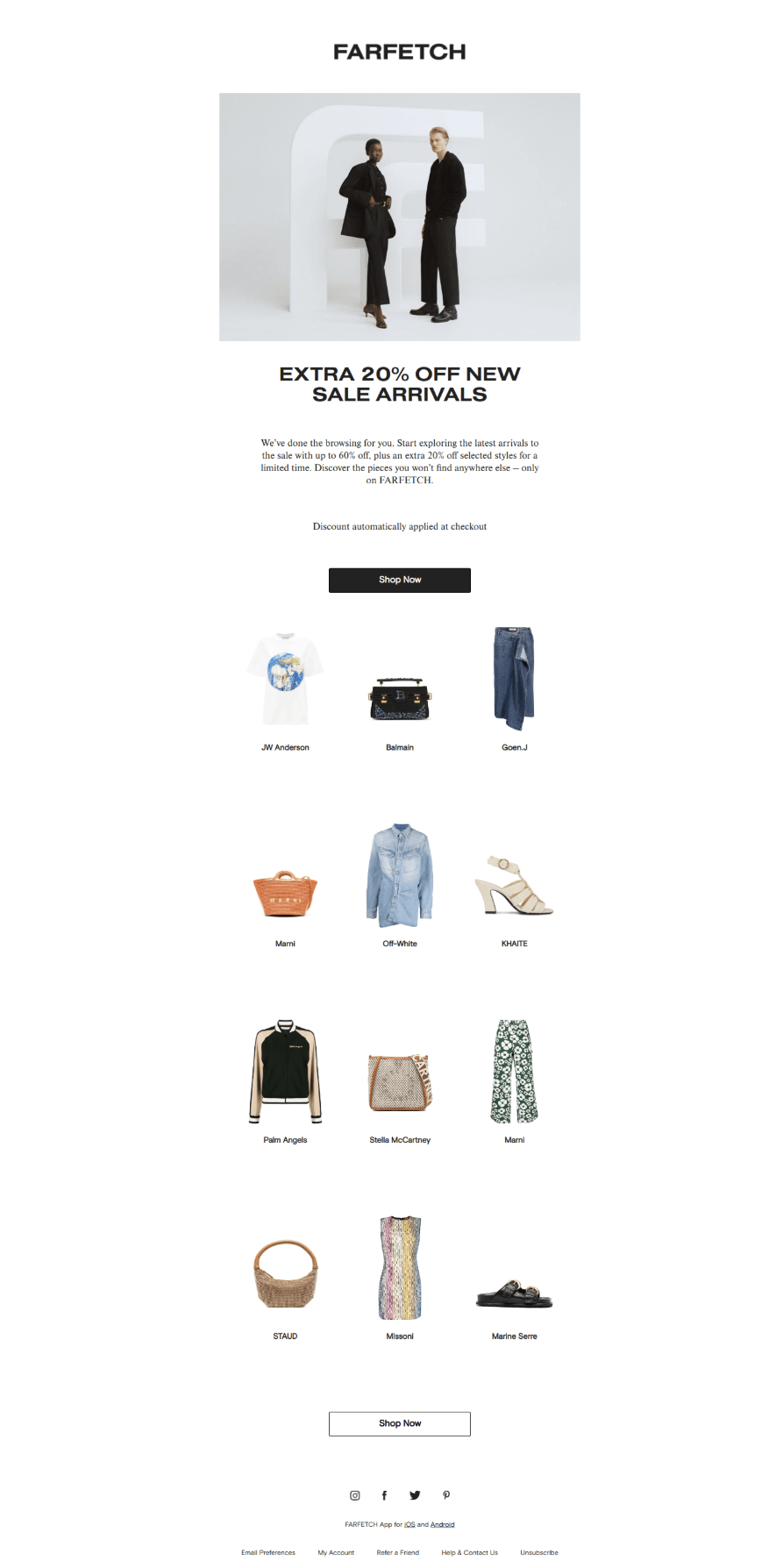
The luxury fashion platform, Farfetch, partnered with Jacquard (formerly Phrasee) to boost its email performance. Jacquard is an AI copywriting tool that fine-tunes brand messaging.
Farfetch used the tool to personalize email content across shopper profiles and product ranges, customize subject lines, and test out different phrasing and tones that would get their audience to click. Rather than replacing human creativity, it streamlined personalization and on-brand messaging.
📈The result
Farfetch gained a 38% increase in average click rates and a 31% surge in open rates, proving that email content personalization can increase engagement.
🔦How can you implement this technique?
Use AI-powered copywriting tools like Jacquard or Grammarly to refine your messaging and test different writing styles. The WebFX exclusive platform, RevenueCloudFX, also optimizes email newsletters. It does so by testing and refining email campaigns using AI-driven insights.
Here’s how you can use these tools in your next AI-powered email campaign:
- Define the goal: Start by choosing one metric you’d like to improve. For example, you could aim to increase the open rate for your weekly newsletter. RevenueCloudFX can help you identify and track improvement areas.
- Generate variations: Use Grammarly or Jacquard to craft personalized messaging. Create more than one version with different tones that will resonate with your audience. Have your marketing team edit the draft to ensure it still sounds human.
- Use A/B tests and analyze results: Do an A/B test on your email campaign to test the versions on different portions of your audience. For example, you could send out two email newsletters with different subject lines to test which one gains more open rates. You’ll then use the more popular tone in future subject lines.
If you prefer a done-for-you solution, you could choose an email marketing service provider that uses AI to improve email campaigns.
10. British Council’s localized AI-powered ads

As a large organization operating in over 100 countries, the British Council needed to reach audiences across multiple languages and platforms. To effectively communicate with their audience, they used AI to generate localized ad variations in seven languages.
📈The result
The process simply required a few clicks and tweaks, saving the British Council’s team valuable time. It created a 50% more efficient turnaround time and reduced marketing content creation costs by 70%.
The organization did not need to exceed its budget or overwork its team to create over 1,000 localized ads. At the same time, they did not use a one-size-fits-all approach. Instead, they created tailored ads for each region.
🔦How can you implement this technique?
While you can do what the British Council did and create high-quality localized ads, you don’t have to be a worldwide brand to adopt this strategy.
If you’re an SMB (small and medium-sized business) with fewer locations, you could adopt this technique by reusing your designs smartly.
Use AI-powered tools and platforms like Canva, AdCreative.ai, and Celtra to adapt your designs across target audiences, locations, and platforms.
You can get started by following these steps:
- Create your foundation ad creative: Create a strong foundational ad creative that you can use as a base for all variations. The design should include a key visual or image, your brand logo and colors, and a primary headline and call-to-action (CTA).
- Define your audience: Define your audience for each variation before generating the variations with your chosen AI tool. This keeps the content and design personal and on-brand, while streamlining processes for your team.
- Generate variations: Upload your master design into the AI-powered tool. Depending on your tool, you can either quickly swap out images and text for specific audiences and locations in Canva or generate complete ad designs tailored for different platforms with AdCreative.ai.
Start implementing powerful AI marketing techniques to gain a competitive advantage
These examples of AI in marketing make it clear that leading brands are using AI to create personalized experiences and more efficient processes.
Adjust these strategies to your company’s needs and goals, and you’ll unlock smarter campaigns, stronger personalization, and improved business outcomes. These outcomes include increased efficiency, enhanced customer experiences, and higher ROI—as evidenced by successful AI-generated ad examples that consistently outperform traditional creative processes.
With a digital marketing agency like WebFX, you can incorporate effective AI solutions. Here, you can leverage WebFX’s customizable AI services, including AI visibility audit services to track your brand in AI search, plus solutions for social media marketing, content marketing, and Search Engine Optimization (SEO).
We have driven 24 million leads for clients and $10 billion in revenue for our clients. Learn more about our AI digital marketing services today to see how they can help you craft targeted marketing campaigns.
-
 Thaakirah Abrahams is a Marketing Editor at WebFX, where she leverages her years of experience to craft compelling website content. With a background in Journalism and Media studies and certifications in inbound marketing, she holds a keen eye for detail and a talent for breaking down complex topics for numerous sectors, including the legal and finance industries. When she’s not writing or optimizing content, Thaakirah enjoys the simple pleasures of reading in her garden and spending quality time with her family during game nights.
Thaakirah Abrahams is a Marketing Editor at WebFX, where she leverages her years of experience to craft compelling website content. With a background in Journalism and Media studies and certifications in inbound marketing, she holds a keen eye for detail and a talent for breaking down complex topics for numerous sectors, including the legal and finance industries. When she’s not writing or optimizing content, Thaakirah enjoys the simple pleasures of reading in her garden and spending quality time with her family during game nights. -

WebFX is a full-service marketing agency with 1,100+ client reviews and a 4.9-star rating on Clutch! Find out how our expert team and revenue-accelerating tech can drive results for you! Learn more
Try our free Marketing Calculator
Craft a tailored online marketing strategy! Utilize our free Internet marketing calculator for a custom plan based on your location, reach, timeframe, and budget.
Plan Your Marketing Budget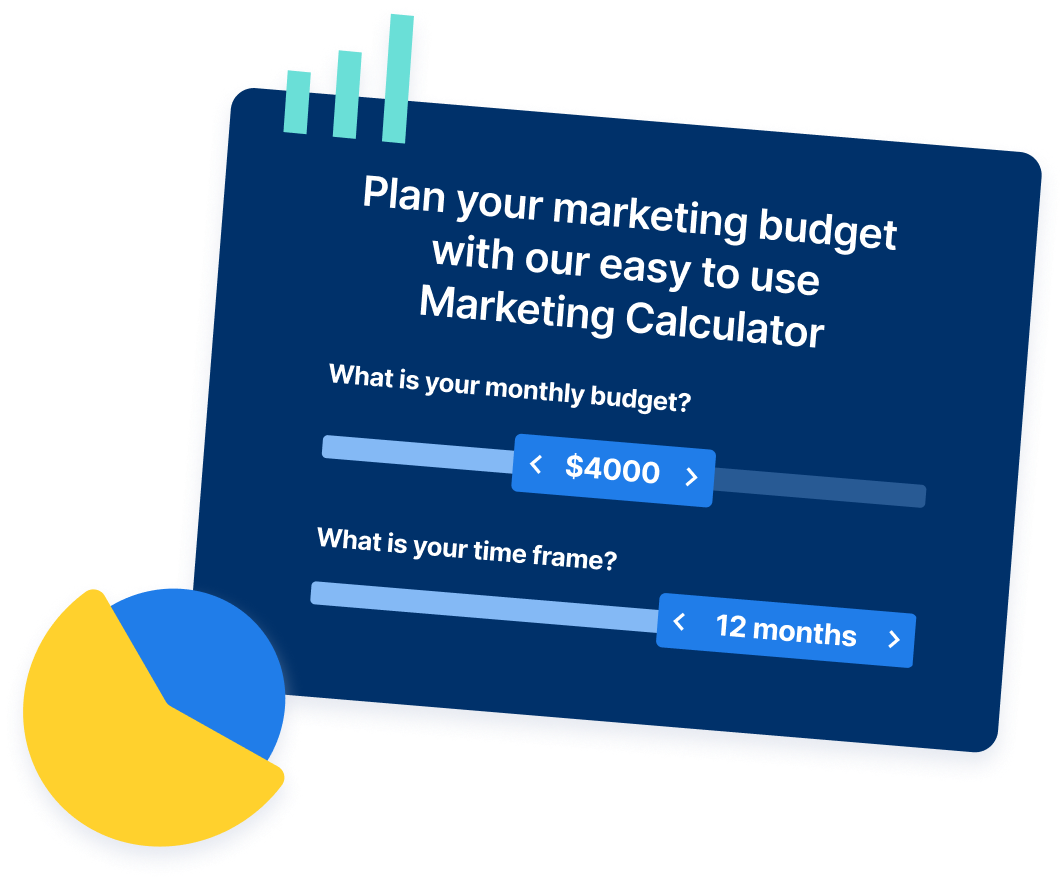
Table of Contents
- Real-world AI marketing examples from top brands
- 1. Coca-Cola’s AI-powered creativity
- 2. Sephora’s AI chatbot-powered shopping service
- 3. Calm App’s use of Amazon Personalize
- 4. Netflix’s user content suggestion tool
- 5. Starbucks’ AI-powered chatbot
- 6. Lidl’s AI-generated product campaign
- 7. BuzzFeed’s AI quizzes
- 8. Nike’s AI-generated ad featuring Serena Williams
- 9. Farfetch’s AI-optimized emails
- 10. British Council’s localized AI-powered ads
- Start implementing powerful AI marketing techniques to gain a competitive advantage

See AI Marketing in Action
Explore how WebFX helped a regional brand get discovered in AI search experiences — proving what’s possible with today’s AI-driven marketing!

Proven Marketing Strategies
Try our free Marketing Calculator
Craft a tailored online marketing strategy! Utilize our free Internet marketing calculator for a custom plan based on your location, reach, timeframe, and budget.
Plan Your Marketing Budget
What to read next


